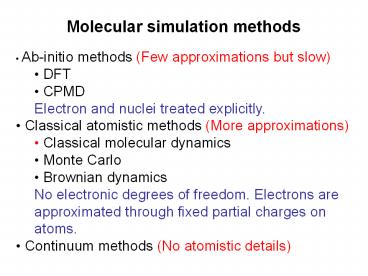Molecular simulation methods - PowerPoint PPT Presentation
Title:
Molecular simulation methods
Description:
Molecular simulation methods. Ab-initio methods (Few approximations but slow) ... Molecular topologies are fixed so the bonded interactions are implemented as ... – PowerPoint PPT presentation
Number of Views:99
Avg rating:3.0/5.0
Title: Molecular simulation methods
1
Molecular simulation methods
- Ab-initio methods (Few approximations but slow)
- DFT
- CPMD
- Electron and nuclei treated explicitly.
- Classical atomistic methods (More
approximations) - Classical molecular dynamics
- Monte Carlo
- Brownian dynamics
- No electronic degrees of freedom. Electrons are
approximated through fixed partial charges on
atoms. - Continuum methods (No atomistic details)
2
(No Transcript)
3
(No Transcript)
4
Implementation of classical interactions
- Molecular topologies are fixed so the bonded
interactions are implemented as static neighbor
lists - One time expense in the beginning
- Non-bonded interactions are implemented as
dynamic neighbor lists - Usually not updated at every time step
- Only two body interactions, so relatively easy
to implement.
5
Reactive systems
- Chemical reactions are association and
dissociation of chemical bonds - Classical simulations cannot simulate reactions
- ab-initio methods calculate overlap of electron
orbitals to investigate chemical reactions - ReaX force field postulates a classical bond
order interaction to mimic the association and
dissociation of chemical bonds1
1 van Duin et al , J. Phys. Chem. A, 105, 9396
(2001)
6
(No Transcript)
7
Bond order interaction
- After correction the bond order between a pair
of atoms depends on the uncorrected bond orders
of the neighbors of each atoms - The uncorrected bond orders are stored in a tree
structure for efficient access. (I think Metin
will be able to elaborate on this) - The bond orders rapidly decay to zero as a
function of distance so it is reasonable to
construct a neighbor list for efficient
computation of bond orders
8
Neighbor lists for bond order
9
Bond order Choline
10
Bond order Benzene
11
Other local energy terms
- The other interaction terms common to classical
simulations, e.g. bond energy, valence angle and
torsion, are appropriately modified and
contribute for non-zero bond order pairs of atoms - These terms also become many body interactions
as bond order itself depends on the neighbors and
neighbors neighbors - Due to variable bond structure there are other
interaction terms, such as over/under
coordination energy, lone pair interaction, 3 and
4 body conjugation, and three body penalty energy
12
Non bonded van der Waals interaction
- The van der Waals interactions are modeled using
distance corrected Morse potential - Where R(rij) is the shielded distance given by
13
Electrostatics
- Shielded electrostatic interaction is used to
account for orbital overlap of electrons at
closer distances - The long range electrostatics interactions are
handled using the Fast Multipole Method (FMM).
14
FMM method
15
Charge equilibration (QEq) method
- The fixed partial charge model used in classical
simulations is inadequate for reacting systems.
Ideally one would like to compute the partial
charges on atoms at each time step using some
ab-initio method. - We compute the partial charges on atoms at each
time step using a simplified approach call Qeq
method - We expand electrostatic energy as a Taylor
series in charge around neutral charge
16
Charge equilibration (QEq) method
- Further we identify the term linear in charge as
electronegativity of the atom and the qudratic
term as electrostatic potential and self energy - Thus we optimize the
- where
- for qi under charge neutrality constraint
17
Charge equilibration (QEq) method
- This constraint optimization problem is
rewritten as two vector unconstraint optimization
problem using Lagranges multiplier method - The unconstraint system is solved using GMRES
method (Please add details of the method)

